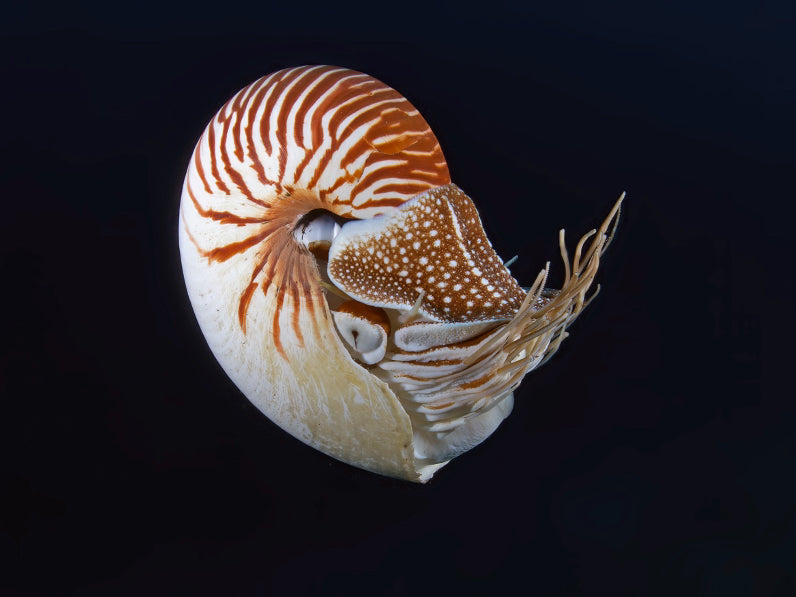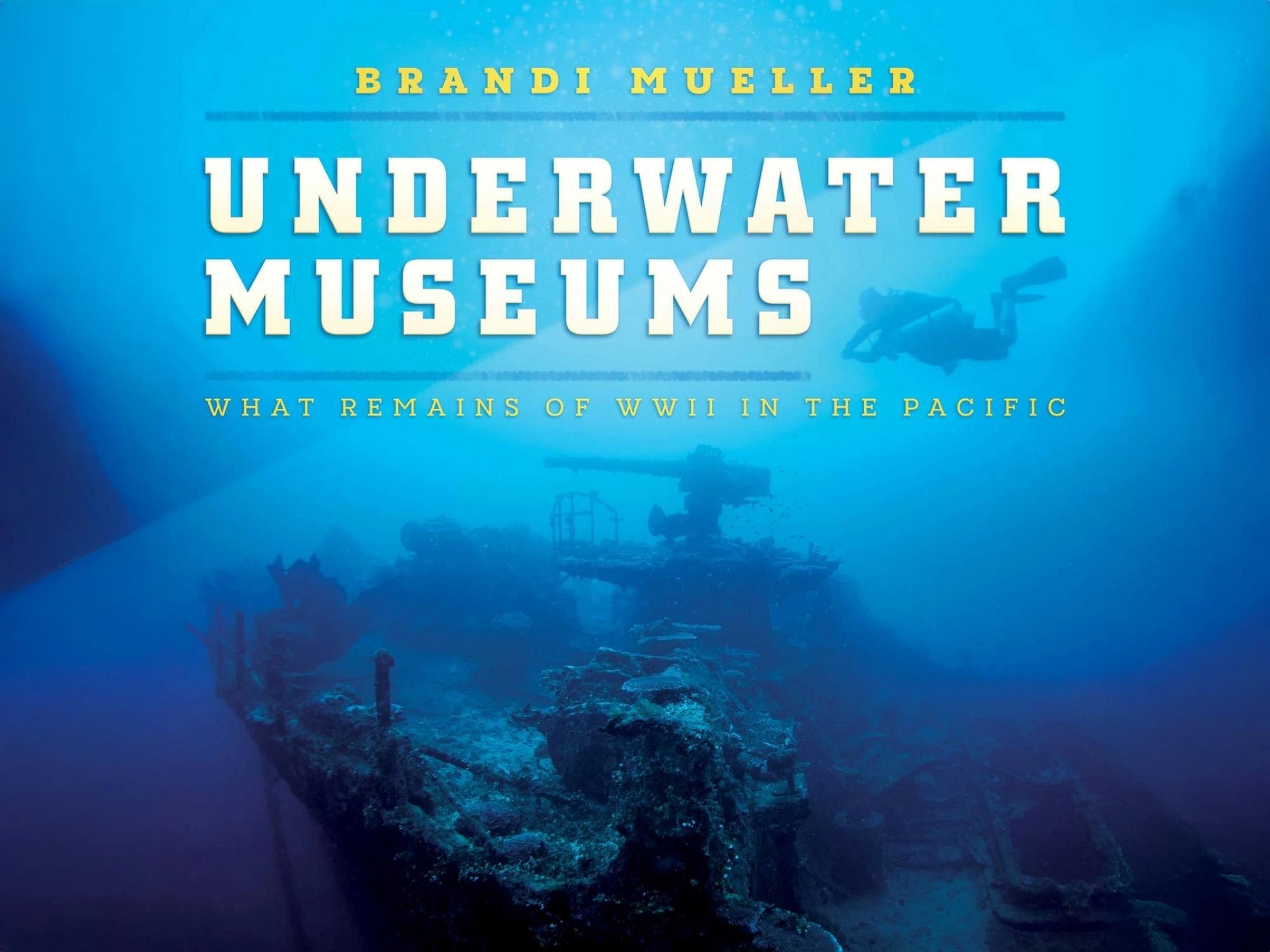By Bruce Carlson and Marj Awai
Cover photo © Marj Awai
There may be life in your underwater movies shot decades ago on 8mm and Super-8 film. Assuming they have been stored in a dust-free, low-humidity environment, they may still have scenes worth watching again.
In 1978, Mike deGruy and I wanted to document our research on the Chambered Nautilus in Palau. Nautilus live in water too deep for recreational scuba divers to see them (except sometimes at night in cooler regions such as New Caledonia). As a consequence, little was known about the activities of Nautilus living on deep-reefs of the west Pacific. Mike and I thought we might learn more by attaching transmitters to them to track their movements. We also wanted to document our work by shooting a Super-8 film, which is all we could afford on our meager graduate student budgets.
I had a Kodak Super-8 movie camera and fortunately Ikelite had a housing for it. We already had years of experience shooting photographs underwater with our Ikelite housings, so we had a good background for shooting underwater movies. The camera had only focus and exposure controls: no white balance, no lights, no monitor, but it did work. We succeeded in tagging a Nautilus, gathered some preliminary data, and after much cutting and splicing, we produced our documentary. The final movie was shown a few times to friends and colleagues, but ultimately it ended up in a box all but forgotten for decades.
1978 Kodak super-8 Nautilus Documentary
Don't try this at home: Before you are tempted to catch Nautilus and photograph them, understand that they do not survive long at surface temperatures. They are extremely vulnerable and should be handled only under the supervision of trained professionals. Scroll to read about the precautions taken by Bruce, Marj, and their team of researchers with the University of Hawai'i.
Going Digital
Recently I found our old film and decided to make a digital scan. I sent it to Scan Café and they did a good job creating an SD480 copy. Then I used Topaz Video AI to sharpen and upscale the video to HD1080 resolution, and finally finished by editing in Final Cut Pro X for color grading and stabilizing much of the shaky footage. I could not remove the dust and scratches, but I decided I actually liked that “effect” because it really looked like a film from half-century ago.
In 1978, only a handful of people saw the original movie, but today with YouTube, Facebook and other social media, even an old super-8 movie can have a new life with a world-wide audience. More importantly, with scanning, upscaling and linear editing tools, an old super-8 movie can look even better than the original.
I am retired now, but my wife, Marj Awai, and I have continued research on Nautilus over the decades and recently collected Nautilus in the Solomon Islands to gather tissue samples for DNA analysis. And we have also continued to document our work, but now we have Canon R5 cameras and Ikelite housings recording in 4K60 – a vast improvement over what we could do back in 1978.
Anatomy and Habitat of Nautilus
The Chambered Nautilus is the common name for cephalopod molluscs related to cuttlefish, squid, and octopus. There are at least seven species in the genus Nautilus and probably two more species in the closely related genus Allonautilus. All of them live on deep reefs in the west Pacific.
These animals have an external spiral shell with chambers inside. These chambers are initially filled with seawater when they form, then the water is removed and gas at less than 1atm remains in the chamber so they are neutrally buoyant.
Contrary to popular belief, they do not flood the chambers to go down; propulsion up, down or sideways is accomplished by shooting water through a siphon-like structure, called the hyponome, similar to the siphon of an octopus.
All species of Nautilus are primarily scavengers living at depths of about 100 meters to a maximum of about 800 meters, below which the shell implodes. Highly diverse, chambered-shells of extinct species, show that Nautilus has a long history that can be traced back nearly 500 million years.
Nautilus: Solomon Islands, 2023-24
Capturing Nautilus is technically not difficult. The problem is too often they are not appropriately handled after capture. All Nautilus that we captured were released after taking measurements and photographs using strict safety guidelines. All Nautilus are protected by the Convention on the International Trade in Endangered Species (CITES) so buying shells and bringing them back home is now illegal without proper permits.
Nautilus Research with the University of Hawai'i
Our primary objectives working with Nautilus were to learn how to maintain them in captivity, and to obtain embryos for study. Even though these animals live in very deep water, they can be brought to the surface without suffering any adverse effects, provided they are kept cold. In the aquarium, they do not need to be kept pressurized, but light and temperature need to be controlled.
Palau Nautilus migrates to shallower water at night (about 300 feet [91.4 meters]) where it is warmer, and descend to deeper, colder water at dawn. To mimic this, we varied the daily temperature regime from about 65ºF (18.3ºC) or colder, up to a maximum of 72ºF (22.2ºC). They are always kept as dark as possible and whole shrimp is the usual food.
While Nautilus acclimate easily to aquarium conditions, it took over ten years to learn how to obtain embryos. We discovered that the eggs need to be maintained at about 72ºF (22.2ºC) and gestation takes up to one year! They hatch out as miniature adults. Understanding the embryology of the chambered nautilus was long considered the “holy grail” of invertebrate zoology.
The first description of a Nautilus embryo based on our work appeared in the journal Science in 1986. Our Nautilus research from 1976 - 2002 was conducted at the Waikiki Aquarium which is administered by the University of Hawai’i. Co-authors on some of our publications include Dr. John Arnold, and Dr. Peter Ward.
Read the latest research: Nautilus belauensis population demographics and trap yields in Palau were similar between surveys in 1982 and 2015
Protecting Nautilus
Nautilus shells are beautiful and sought after by collectors, and rare species can command a very high price. Unfortunately, Nautilus are easily captured in traps, but they have a low reproductive rate. As a result, some populations especially in the Philippines have been exterminated for the international shell trade. For this reason, efforts were made to control or prohibit the trade in Nautilus shells through the Convention on the International Trade in Endangered Species (CITES). Today all species of Nautilus and Allonautilus are protected under CITES; obtaining a shell overseas and bringing it home is illegal without proper documentation.
Dive operators may offer patrons the opportunity to photograph living Nautilus. This should be avoided as there are strict protocols needed to ensure the Nautilus safety. Photographing Nautilus should be done only under the oversight of trained professionals who understand the nuance of ensuring their protection.

Bruce Carlson has been shooting underwater photos since 1972 using Ikelite housings. His wife, Marj Awai, moved from a Nikonos camera to an Ikelite housing in 1984 after meeting Bruce. Together they have captured images for educational purposes, with many of Marj’s photos used in museum and aquarium graphics, educational books and magazine articles. Bruce now shoots mostly video. Both are retired from careers at the Bishop Museum, the Waikiki Aquarium, the Florida Aquarium, the Georgia Aquarium, and Aulani – a Disney Resort and Spa. Videos featuring their combined images can be viewed on YouTube @Exallias1.

Mike deGruy became a multiple Emmy and Bafta award winning filmmaker. Among his many credits both behind and in front of the camera are Trials of Life, Blue Planet, Life in the Freezer, Pacific Abyss, and Incredible Suckers. His TED Talk ‘Hooked by an Octopus’ has been viewed over a million times. Tragically, his life ended too soon when he died in a helicopter crash in 2012 while working on James Cameron’s Deepsea Challenge. Photo courtesy of Mimi deGruy.
We want to thank Mimi deGruy and Lori Colin for contributing comments and ideas for this film production and article.
Additional Reading
First Results // Topaz Photo AI Enhancement of Underwater Images
Real World Tips for Charging and Data Transfer with the Ikelite USB-C Bulkhead
The Power of Underwater Photography for Ocean Conservation
Canon R5 A-Z // Setting up Ikelite Underwater Strobes with DL5 DS Link TTL Converter [VIDEO]
Featured Customers | Ruijie The Art of Underwater Photography on Film
The Story of Ikelite | Making Underwater Photography Accessible [VIDEO]












![Chasing the Sardine Run Underwater in South Africa [VIDEO]](http://www.ikelite.com/cdn/shop/articles/Sardine_Run_Expedition_South_Africa_copy.jpg?v=1725375302&width=2000)
